-

U.S. Steel recognition strike of 1901
The U.S. Steel recognition strike of 1901 was an attempt by the Amalgamated Association of Iron, Steel and Tin Workers (the AA) to reverse its declining fortunes and organize large numbers of new members. The strike failed.
-

Gospel riots
The Gospel riots (Greek: Ευαγγελικά, Evangelika), which took place on the streets of Athens in November 1901, were primarily a protest against the publication in the newspaper Akropolis of a translation into modern spoken Greek of the gospel of St Matthew, although other motives also played a part. The disorder reached a climax on 8 November, "Black Thursday", when eight demonstrators were killed.[a]
-

Września children strike
Września school strike or Września children strike refers to the protests of Polish children and their parents against Germanization that occurred in Września in the years 1901–1904.
-

Belgian general strike of 1902
The general strike of 1902 (French: grève générale de 1902, Dutch: algemene staking van 1902) was a major general strike in Belgium, aimed at forcing electoral reform and notably the end of the system of plural voting. It officially lasted between 10 and 20 April. The 1902 strike was the second general strike in Belgium's history and although the largest, it was ultimately unsuccessful at achieving its objectives.
-
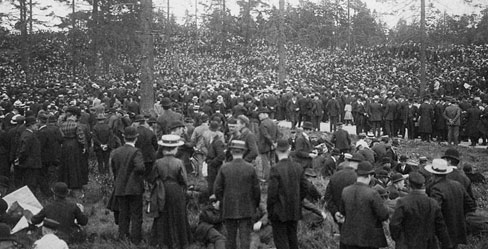
Storstrejken i Sverige 1902
Storstrejken i Sverige 1902 var en politisk strejk i Sverige 15-17 maj 1902, som användes för att få allmän och lika rösträtt till Sveriges riksdags då två kammare.
-

Расстрел демонстрации в Златоусте (1903)
Расстрел демонстрации в Златоусте — события, развернувшиеся 11 (24) марта — 13 (26) марта 1903 года во время забастовки златоустовских рабочих, в ходе которых погибли 69 человек, более 250 были ранены, более 100 арестованы.
-

Всеобщая стачка на Юге России
Всеобщая стачка на Юге России — первое массовое организованное выступление рабочих Юга Российской империи, в том числе Закавказья и части современной Украины.
-

Kishinev pogrom
The Kishinev pogrom was an anti-Jewish riot that took place in Kishinev (modern Chișinău, Moldova), then the capital of the Bessarabia Governorate in the Russian Empire, on April 19–21 [O.S. April 6– 1903. Further rioting erupted in October 1905. In the first wave of violence, beginning on Easter Day, 49 Jews were killed, a number of Jewish women were raped and 1,500 homes were damaged. American Jews began large-scale organized financial help, and assisted in emigration. The incident focused worldwide attention on the persecution of Jews in Russia and led Theodor Herzl to propose the Uganda Scheme for resettlement of the Jews.
-

Railroad strikes of 1903 in the Netherlands
The railroad strikes of 1903 were strikes in the Netherlands, of the railway staff, regarding the right of workers to organize into a union and negotiate and implement the right to strike.
-

1903 water riots
The 1903 water riots took place at Port of Spain in the then British colony Trinidad and Tobago. As a result of the riots, the Red House, which was the seat of the Executive and Legislative Council was destroyed.
-

Crimmitschauer Streik
Der Crimmitschauer Streik der Textilarbeiter von Crimmitschau im Königreich Sachsen dauerte vom August 1903 bis in den Januar 1904. Der Streik beziehungsweise die Aussperrung löste sowohl unter der organisierten Arbeiterschaft wie auch unter den Arbeitgebern eine beispiellose breite reichsweite Solidarisierung mit den lokalen Konfliktparteien aus. Die öffentliche Meinung war klar auf Seiten der Streikenden. Der Konflikt endete mit einer klaren Niederlage der Arbeiter; er hatte langfristig Auswirkungen auf die Bildung der Arbeitgeberverbände.
-
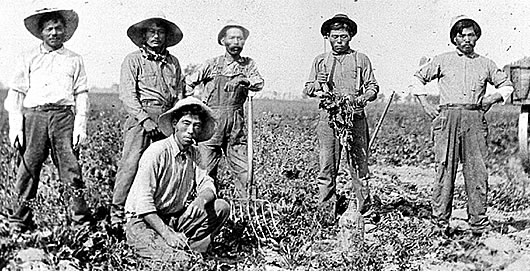
Oxnard strike of 1903
The Oxnard strike of 1903 was a labor rights dispute in the southern California coastal city of Oxnard between local landowners and the majority Japanese and Mexican labor force.
-

Idaho Springs miners' strike of 1903
The Idaho Springs miners strike of 1903 was a labor strike by members of the Western Federation of Miners (WFM) against gold mines in the vicinity of Idaho Springs, Colorado. It is one of the strikes of 1903-1904 that are collectively known as the Colorado Labor Wars. The union demanded a reduction in the working day to eight hours, without a corresponding reduction in pay. The strike began on 1 May 1903, and was called off on 1 September 1903. The strike is noted for a dynamite attack on the Sun and Moon mine, and the forcible deportation of 19 union officials and union members from the area.
-

Carbon County Strike
The Carbon County Strikes took place in Carbon County, Utah from 1903–1904. The strikes primarily consisted of Slavic and Italian immigrant mine workers who partnered with the United Mine Workers of America strikes in Colorado to protest the dangerous working conditions of the Utah coal mines. The Carbon County strikes were considered the most important labor confrontation in the United States at the time.[citation needed] The Utah Fuel Company strongly opposed initiatives to unionize coal workers in Utah and were the primary opposition to the UMWA at the time. The Carbon County Strikes would ultimately fail in its attempt to unionize the coal workers of Utah simply because it "did not have enough support, either internally or externally, to win against a powerful and influential company that effectively played on radical, anti-foreign sentiments in defending its position" but it demonstrated a significant nationwide effort in strengthening unionization in the west.
-

Pacific Electric Railway strike of 1903
The Pacific Electric Railway strike of 1903 was an industrial dispute between Mexican tracklayers and their employers on the construction of the Main Street streetcar line in Los Angeles. The dispute began on April 24 when the workers, known as the "Traqueros", demanded higher wages to match those of the European immigrants working on the same project, and stopped work. It ended on April 29 when the union organising the strike failed to persuade workers on rest of the streetcar system to join the strike, and the labourers returned to work.
-

1904 Italian general strike
In September 1904, the first general strike in Italy took place.
-

St. Louis bullfight riot
On June 5, 1904, thousands of people rioted in St. Louis, Missouri just north of the 1904 World's Fair after a bullfight was canceled by court order. The St. Louis bullfight riot resulted in a handful of injuries and the complete destruction (by fire) of the Norris Amusement Company arena. The riot disrupted the World's Fair for one day, and one bullfighter murdered another shortly after the riot, an action indirectly attributed to the incident.
-

Бакинская стачка (1904)
Бакинская стачка 1904 года — стачка бакинских рабочих, организованная независимым профсоюзом 13(26) декабря 1904 года. Она стала первым в истории рабочего движения России примером заключения коллективного договора с нефтепромышленниками. В ней руководящую роль приняли местный комитет РСДРП и Сталин.
-
Январская забастовка 1905 года
Январская забастовка 1905 года — забастовка московских рабочих, которая началась 10 января 1905 года как протест против расстрела петербургских рабочих 9 января.
-

Pogromul de la Chișinău (1905)
Pogromul de la Chișinău din 1905 a fost un incident violent care a avut loc în data de 19 octombrie 1905 la Chișinău, după doi ani și jumătate de la pogromul din 1903.
-

Ruimveldt Riots (1905)
The Ruimveldt Riots took place in British Guiana (today Guyana) in 1905. It reflected the widespread dissatisfaction among workers with their standards of living.[citation needed] The uprising began in late November 1905 when the stevedores – dockworkers – of the capital Georgetown went on strike and demanded higher wages. The strike grew, with many workers joining in an alliance. On 1 December 1905 – today known as "Black Friday" – the situation came to a head. At the Plantation Ruimveldt, not far from Georgetown, a large crowd of porters refused a demand by the police and a detachment of artillery to disperse. The colonial forces opened fire, and four workers were seriously injured.
-

Bergarbeiterstreik von 1905
Der Bergarbeiterstreik von 1905 war der zweite große Streik der Bergarbeiter im Ruhrbergbau.
-

Grande grève de 1905 en Finlande
Suurlakko est une grève générale révolutionnaire qui a eu lieu en octobre-novembre 1905 dans l'Empire russe et le grand-duché de Finlande.
-

Meat riots
The Meat riot (Spanish: Huelga de la carne), in the Chilean capital Santiago in October 1905, was a violent riot that originated from a demonstration against the tariffs applied to the cattle imports from Argentina.
-

1905 Chicago teamsters' strike
The 1905 Chicago Teamsters' strike was a sympathy strike and lockout by the United Brotherhood of Teamsters in the summer of 1905 in the city of Chicago, Illinois. The strike was initiated by a small clothing workers' union. But it soon spread as nearly every union in the city, including the Teamsters, supported the job action with sympathy strikes. Initially, the strike was aimed at the Montgomery Ward department store, but it affected almost every employer in the metropolitan region after the Teamsters walked out. The strike eventually pitted the Teamsters against the Employers' Association of Chicago, a broad coalition of business owners formed a few years earlier to oppose unionization in Chicago.
-
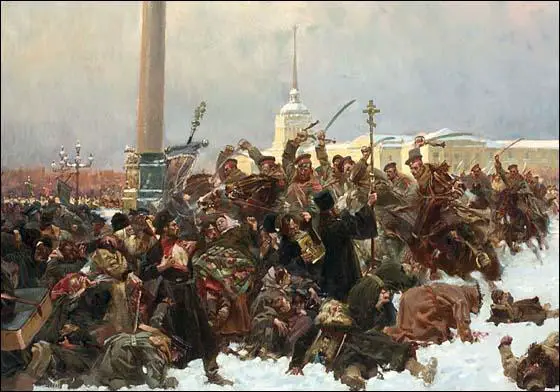
Bloody Sunday (1905)
Bloody Sunday or Red Sunday (Russian: Крова́вое воскресе́нье, tr. Krovávoye voskresén'e, IPA: [krɐˈvavəɪ vəskrʲɪˈsʲenʲjɪ]) is the name given to the events of Sunday, 22 January [O.S. 9 January] 1905 in St Petersburg, Russia, when unarmed demonstrators, led by Father Georgy Gapon, were fired upon by soldiers of the Imperial Guard as they marched towards the Winter Palace to present a petition to Tsar Nicholas II of Russia.
-

Alfonse Pogrom
The Alfonse pogrom (in the Polish, Pogrom alfonsów, "pogrom of the pimps” – the Polish- language slang term "alfons" means "pimp"; 24–26 May 1905) was a three-day riot in Warsaw, Poland. The violence led to the destruction of several dozen brothels, and to as many as 15 deaths. Accounts and analyses of the event differ with regard to its goals and participants (varying as to the participation of Jewish Bund labor-party militants, Jewish workers, Christian workers, and criminals; as well as to the genesis of the event and the exact numbers of casualties).
-

Hibiya incendiary incident
The Hibiya incendiary incident (日比谷焼打事件, Hibiya yakiuchi jiken), also known as the Hibiya riots, was a major riot that occurred in Tokyo, Japan, from 5 to 7 September 1905. Residents of Tokyo protesting in Hibiya Park against the terms of the Treaty of Portsmouth ending the Russo-Japanese War escalated into a violent two-day citywide riot when the police attempted to suppress the protest. The Hibiya incendiary incident resulted in the death of 17 people, led to the collapse of the government of Katsura Tarō, and is considered the first event of the Era of Popular Violence.
-
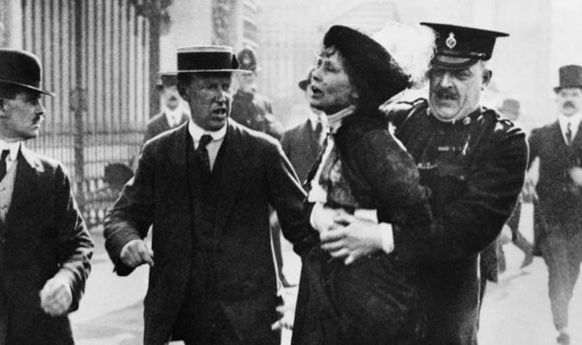
1906 WSPU march
The 1906 WSPU march on 19 February 1906 was the first march held in London to demand the right to vote for women in the United Kingdom. Organized by Sylvia Pankhurst and Annie Kenney of the Women's Social and Political Union (WSPU), the event saw around 300–400 women march through central London to the House of Commons. It was held to coincide with the King's Speech and the opening of Parliament.
-

Cananea strike
The Cananea strike, also known as the Cananea riot, or the Cananea massacre, took place in the Mexican mining town of Cananea, Sonora, in June 1906. Although the workers were forced to return to their positions with no demand being met, the action was a key event in the general unrest that emerged during the final years of the regime of President Porfirio Díaz and that prefigured the Mexican Revolution of 1910. In the incident twenty-three people died, on both sides, twenty-two were injured, and more than fifty were arrested.
-
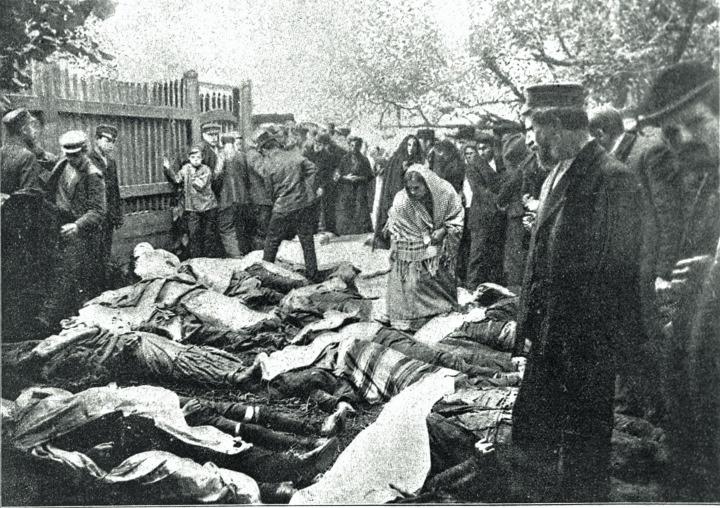
Białystok pogrom
The Belostok (Białystok) pogrom occurred between 14–16 June 1906 (1–3 June Old Style) in Białystok, Poland (then part of the Russian Empire). During the pogrom between 81 and 88 people were killed by soldiers of the Imperial Russian Army, the Black Hundreds and the Chernoe Znamia, and about 80 people were wounded.
-

Mud March (suffragists)
The United Procession of Women, or Mud March as it became known, was a peaceful demonstration in London on 9 February 1907 organised by the National Union of Women's Suffrage Societies (NUWSS), in which more than three thousand women marched from Hyde Park Corner to the Strand in support of women's suffrage. Women from all classes participated in what was the largest public demonstration supporting women's suffrage seen up to that date. It acquired the name "Mud March" from the day's weather, when incessant heavy rain left the marchers drenched and mud- spattered.
-
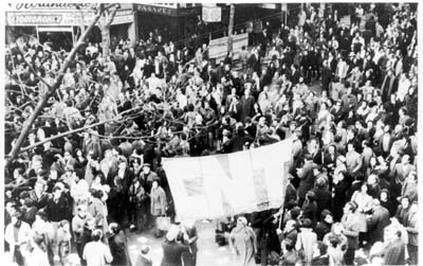
Río Blanco strike
The Río Blanco strike of January 7 and 8, 1907 was a workers' riot related to a textile strike, near Orizaba in the Mexican state of Veracruz.
-

Anti Oriental riots (Vancouver)
The Vancouver riots occurred September 7–9, 1907, in Vancouver, British Columbia, Canada. At about the same time there were similar anti-Asian riots in San Francisco, Bellingham, Washington, and other West Coast cities. They were not coordinated, but instead reflected common underlying anti-immigration attitudes. Agitation for direct action was led by labour unions and small business.:163 No one was killed but the damage to Asian-owned property was extensive. One result was an informal agreement whereby the government of China stopped emigration to Canada.
-

Huelga de inquilinos de 1907
La Huelga de inquilinos o huelga de las escobas de 1907 fue un movimiento popular contra la suba de los alquileres en las casas de inquilinato de Buenos Aires y otras ciudades argentinas, popularmente denominadas conventillos. La huelga se inició en agosto de 1907, duró aproximadamente 3 meses y participaron del movimiento más de cien inquilinatos con 32 mil obreros en huelga. Tuvo una importante presencia de activistas anarquistas y socialistas.
-

San Francisco streetcar strike of 1907
The San Francisco streetcar strike of 1907 was among the most violent of the streetcar strikes in the United States between 1895 and 1929. Before the end of the strike, thirty-one people had been killed and about 1100 injured.
-
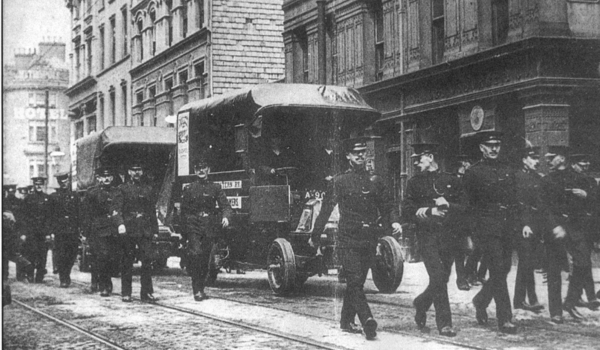
1907 Belfast Dock strike
The Belfast Dock strike or Belfast lockout took place in Belfast, Ireland from 26 April to 28 August 1907. The strike was called by Liverpool- born trade union leader James Larkin who had successfully organised the dock workers to join the National Union of Dock Labourers (NUDL). The dockers, both Protestant and Catholic, had gone on strike after their demand for union recognition was refused. They were soon joined by carters, shipyard workers, sailors, firemen, boilermakers, coal heavers, transport workers, and women from the city's largest tobacco factory. Most of the dock labourers were employed by powerful tobacco magnate Thomas Gallaher, chairman of the Belfast Steamship Company and owner of Gallaher's Tobacco Factory.
-

1907 Romanian Peasants' Revolt
The 1907 Romanian Peasants' Revolt took place between 21 February and 5 April 1907. It started in northern Moldavia and, after three weeks in which it was localized in that area, it quickly spread, reaching Wallachia, including as far as Oltenia. The main cause was the discontent of the peasants over the inequity of land ownership, which was in the hands of just a few large landowners.
-

Tinnevely riot of 1908
The Tinnevely riot is an outbreak of violence which occurred in the town of Tinnevely in then Madras Presidency of British India on 17 March 1908. The outbreak was in response to the arrest and subsequent conviction of Indian nationalists Subramania Siva and V. O. Chidambaram Pillai.
-

Pensacola streetcar strike of 1908
A strike of streetcar operators took place in Pensacola, Florida from April 5 to May 13, 1908. It was staged by employees of the Pensacola Electric Company over a company rule requiring workers whom the company had suspended for whatever reason to report to the company's car barn thrice daily for a roll call. During the 39-day strike, open violence erupted in Pensacola's streets, resulting in at least one death, after which martial law was declared and the state militia was sent to provide security to the company strikebreakers.
-

Springfield race riot of 1908
The Springfield race riot of 1908 were events of mass racial violence committed against African Americans by a mob of about 5,000 white Americans and European immigrants in Springfield, Illinois, between August 14 and 16, 1908. Two black men had been arrested as suspects in a rape, and attempted rape and murder. The alleged victims were two young white women and the father of one of them. When a mob seeking to lynch the men discovered the sheriff had transferred them out of the city, the whites furiously spread out to attack black neighborhoods, murdered black citizens on the streets, and destroyed black businesses and homes. The state militia was called out to quell the rioting.
-

Red Flag Incident
The Red Flag Incident (Japanese: 赤旗 事件, Hepburn: Akahata Jiken) refers to a political rally that took place in Tokyo, Japan, on June 22, 1908.
-

Tragic Week (Spain)
Tragic Week (in Catalan la Setmana Tràgica, in Spanish la Semana Trágica) (25 July – 2 August 1909) was a series of violent confrontations between the Spanish army and anarchists, socialists and republicans of Barcelona and other cities in Catalonia, Spain, during the last week of July 1909. It was caused by the calling-up of reserve troops by Premier Antonio Maura to be sent as reinforcements when Spain renewed military- colonial activity in Morocco on 9 July, in what is known as the Second Rif War. Many of these reservists were the only breadwinners for their families, while the wealthy were able to hire substitutes.
-

Pressed Steel Car strike of 1909
The Pressed Steel Car strike of 1909, also known as the "1909 McKees Rocks strike," was an American labor strike which lasted from July 13 through September 8. The walkout drew national attention when it climaxed on Sunday August 22 in a bloody battle between strikers, private security agents, and the Pennsylvania State Police. At least 12 people died, and perhaps as many as 26. The strike was the major industrial labor dispute in the Pittsburgh district after the famous 1892 Homestead strike and was a precursor to the Great Steel Strike of 1919.
-

Greek Town riot
The Greek Town riot was a race riot in South Omaha, Nebraska on February 21, 1909. 3,000 men were responsible for killing one boy, displacing the entire population of Greek Town, and burning down the Greek neighborhood in South Omaha.
-

New York shirtwaist strike of 1909
The New York shirtwaist strike of 1909, also known as the Uprising of the 20,000, was a labour strike primarily involving Jewish women working in New York shirtwaist factories. It was the largest strike by female American workers up to that date. Led by Clara Lemlich and the International Ladies' Garment Workers' Union, and supported by the National Women's Trade Union League of America (NWTUL), the strike began in November 1909.
-

Swedish general strike
The Swedish general strike (Swedish: Storstrejken) of August 4 to September 4, 1909, was a general work stoppage by over 300,000 individuals all over Sweden. It was the first major conflict between the Swedish Trade Union Confederation (Landsorganisationen, LO), and the Swedish Employers Association (Svenska Arbetsgivareföreningen, SAF). The losses to employers was estimated to be around 25 million Swedish kronor.
-

Westmoreland County coal strike of 1910 11
The Westmoreland County coal strike of 1910–1911, or the Westmoreland coal miners' strike, was a strike by coal miners represented by the United Mine Workers of America. The strike is also known as the Slovak Strike because about 70 percent of the miners were Slovak immigrants. It began in Westmoreland County, Pennsylvania, on March 9, 1910, and ended on July 1, 1911. At its height, the strike encompassed 65 mines and 15,000 coal miners. Sixteen people were killed during the strike, nearly all of them striking miners or members of their families. The strike ended in defeat for the union.
-
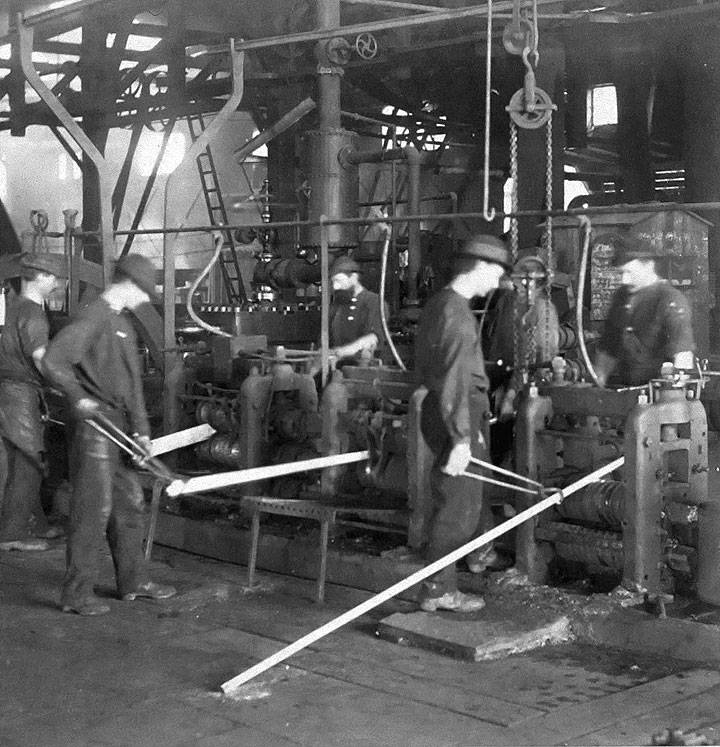
Philadelphia general strike (1910)
The General Strike of 1910 was a labor strike by trolley workers of the Philadelphia Rapid Transit Company that grew to a citywide riot and general strike in Philadelphia, Pennsylvania.
-

Tonypandy riots
The Miners Strike of 1910-11 was an attempt by miners and their families to improve wages and living conditions in severely deprived parts of South Wales, where wages had been kept deliberately low for many years by a cartel of mine owners.
-

Battle of Downing Street
The Battle of Downing Street was a march of suffragettes to Downing Street, London, on 22 November 1910. Organized by Emmeline Pankhurst's Women's Social and Political Union, the march took place four days after Black Friday, a suffragette protest outside the House of Commons that saw the women violently attacked by police.
-

Revolt of the Lash
The Revolt of the Lash[A] (Portuguese: Revolta da Chibata) was a naval mutiny in Rio de Janeiro, Brazil, in late November 1910. It was the direct result of the use of whips ("lashes") by white naval officers when punishing Afro-Brazilian and mulatto enlisted sailors.
-
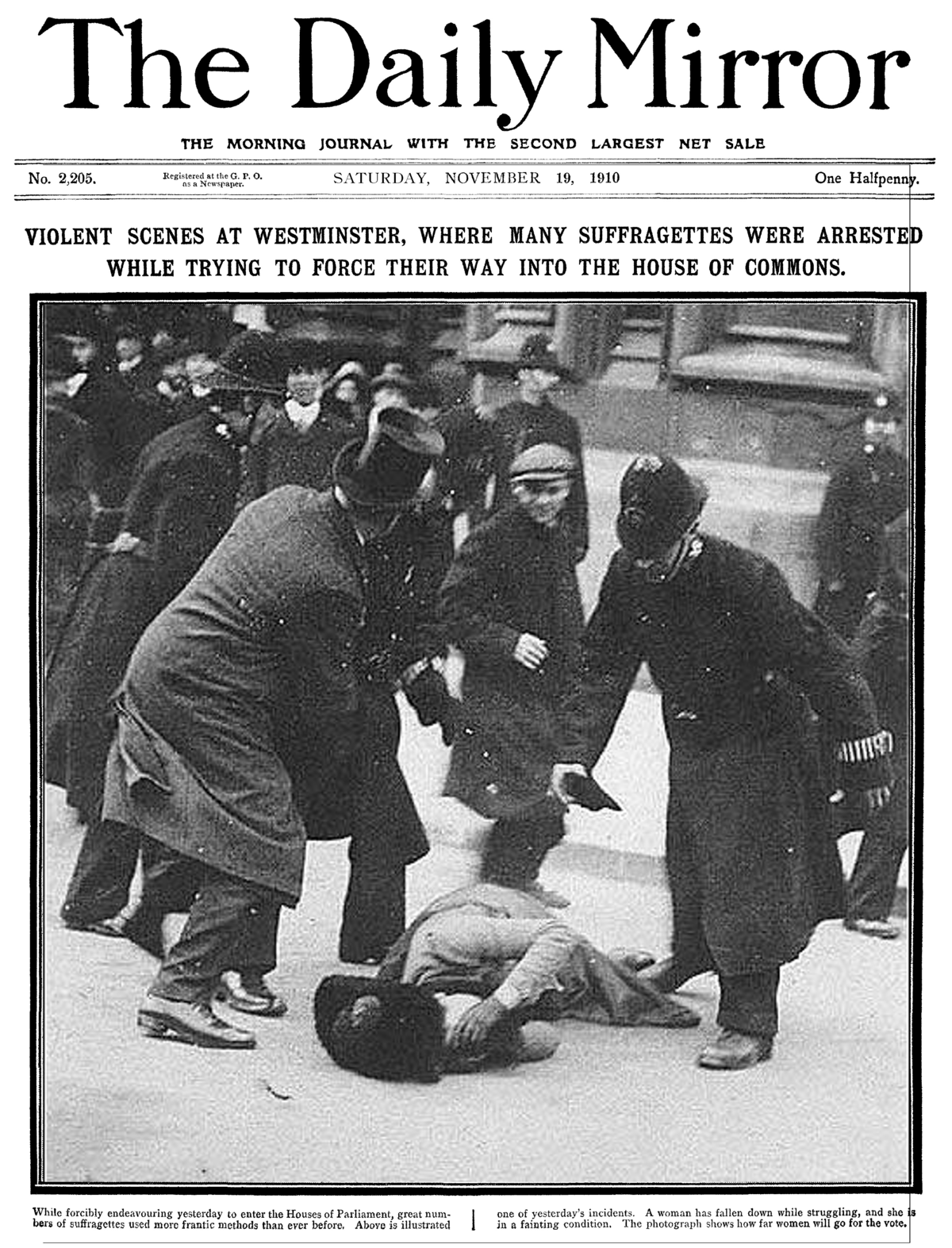
Black Friday (1910)
Black Friday was a suffragette demonstration in London on 18 November 1910, in which 300 women marched to the Houses of Parliament as part of their campaign to secure voting rights for women. The day earned its name from the violence meted out to protesters, some of it sexual, by the Metropolitan Police and male bystanders.
-

Strajk na Uniwersytecie Jagiellońskim (1910 1911)
Strajk na Uniwersytecie Jagiellońskim w 1910 roku (Zimmermaniada) − protesty studenckie przeciwko zatrudnieniu ks. Kazimierza Zimmermanna na Uniwersytecie Jagiellońskim na przełomie 1910 i 1911 roku, zakończone czasowym zamknięciem uczelni.